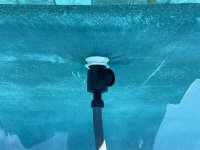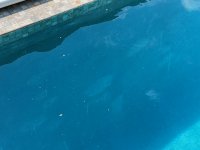We re-plastered our Maryland pool in late 2019. Used a WetEdge Quartz product (link below).
The pool was winterized shortly after the 'curing' period (~30-45 days after plastering). I brushed the pool and did my best to keep the water chemistry in line with WetEdge's 28 day startup guidelines. I had the service company check the chemistry over the winter (though I don't think they did much or anything).
No major issues after opening in 2020 other than a distinctive watermark line on the plaster (water level was reduced for winterization). The plaster above this line (~12in of plaster before tile) looked whiter/washed out. It was a bit unsightly, but didn't worry me much. See picture below under the tile line - there is a white/hazy band.
Fast forward to 2021 - we just recently opened the pool and I noticed a bunch of white streaks along with a lot of general 'mottling' (not sure if that's accurate). I have also noticed some circular discolorations/defects that look kind of like spiderwebs. Or like circular mottling.
Please see the attached 2 pictures. The 2nd picture is of the deep end vertical wall under the auto-cover tile shelf. White streaks + circular defects can be seen here.
My specific concerns are:
Appreciate any/all suggestions. This forum is an amazing resource.
FWIW, I used a WaterLink Spin Touch for testing last year (was trying to save time). I've come to realize it's not accurate across the board. I know this because I have been SLAM'g my pool for almost a week trying to get rid of persistent CCs that wouldn't go away. Today I finally broke out the titration TFT kit and measured CCs at 0! Spintouch is still recording ~3.
Pool Facts: Plaster, Maryland, Auto Cover on 99+% of time, SWG. Salt ~3000. Calcium ~250. CYA was generally low (~20-30) because the autocover is almost always on. pH always seems to be high (I was adding muriatic acid weekly last year and pH seemed to be above 7.5 every time I tested). Heat Pump - water temp is generally high 80s/low 90s during summer (per my wife). I was not familiar with CSI until recently, but when I enter my general #s, the result is not close to less than -.6.
FWIW, the original plaster was white. They acid washed but only chipped away around the tile/fixtures/etc. They did not find any delaminated plaster. They brushed on a concrete looking product that apparently helped the new plaster adhere to the old plaster. Then they sprayed/troweled on the WetEdge, then acid washed again, then filled.
One thing I'll note - even though this was plastered 1.5 years ago, we're still getting quite a bit of 'plaster dust'. It never really stopped.
Thanks for your thoughts!
Wet Edge Luna Quartz St Maarten: Wet Edge | Products | St Maarten
The pool was winterized shortly after the 'curing' period (~30-45 days after plastering). I brushed the pool and did my best to keep the water chemistry in line with WetEdge's 28 day startup guidelines. I had the service company check the chemistry over the winter (though I don't think they did much or anything).
No major issues after opening in 2020 other than a distinctive watermark line on the plaster (water level was reduced for winterization). The plaster above this line (~12in of plaster before tile) looked whiter/washed out. It was a bit unsightly, but didn't worry me much. See picture below under the tile line - there is a white/hazy band.
Fast forward to 2021 - we just recently opened the pool and I noticed a bunch of white streaks along with a lot of general 'mottling' (not sure if that's accurate). I have also noticed some circular discolorations/defects that look kind of like spiderwebs. Or like circular mottling.
Please see the attached 2 pictures. The 2nd picture is of the deep end vertical wall under the auto-cover tile shelf. White streaks + circular defects can be seen here.
My specific concerns are:
- White streaks, mostly on vertical walls, but some formations on the floor as well. Calcium nodules?
- ~12 in white haze under tile from lowering water line
- Circular "spider web"/mottling defects
- General 'mottling' (visually, this doesn't bother me much. But I'm concerned it's a sign of an underlying problem)
Appreciate any/all suggestions. This forum is an amazing resource.
FWIW, I used a WaterLink Spin Touch for testing last year (was trying to save time). I've come to realize it's not accurate across the board. I know this because I have been SLAM'g my pool for almost a week trying to get rid of persistent CCs that wouldn't go away. Today I finally broke out the titration TFT kit and measured CCs at 0! Spintouch is still recording ~3.
Pool Facts: Plaster, Maryland, Auto Cover on 99+% of time, SWG. Salt ~3000. Calcium ~250. CYA was generally low (~20-30) because the autocover is almost always on. pH always seems to be high (I was adding muriatic acid weekly last year and pH seemed to be above 7.5 every time I tested). Heat Pump - water temp is generally high 80s/low 90s during summer (per my wife). I was not familiar with CSI until recently, but when I enter my general #s, the result is not close to less than -.6.
FWIW, the original plaster was white. They acid washed but only chipped away around the tile/fixtures/etc. They did not find any delaminated plaster. They brushed on a concrete looking product that apparently helped the new plaster adhere to the old plaster. Then they sprayed/troweled on the WetEdge, then acid washed again, then filled.
One thing I'll note - even though this was plastered 1.5 years ago, we're still getting quite a bit of 'plaster dust'. It never really stopped.
Thanks for your thoughts!
Wet Edge Luna Quartz St Maarten: Wet Edge | Products | St Maarten



